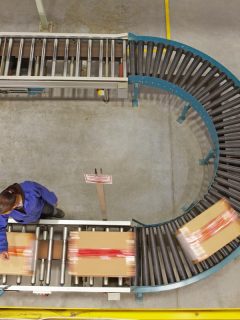According to a 2023 PwC study*, 89% of supply chain managers are convinced that digital technology will have a major impact on their business over the next five years. Among the risks that digital could limit cited by the people questioned in the study are the volatility of demand, shortages of raw materials and pressure on costs.
But what is the current state of supply chain digitalisation? And where are we heading in the future?
This article, based on the figures from this study and the testimonies of the contributors to our white paper “What will the warehouse of the future look like?
Digitalisation of the supply chain: tantalising promises
If there’s so much talk about digital applications in supply chain management, it’s not just a passing trend. Many logistics management specialists are already testifying to the benefits that digitisation can bring to a company.
Here are some of the most frequently cited gains expected from the digitisation of the supply chain:
- Increased productivity. Thanks to automation in the warehouse, throughput can be increased. In fact, 61% of supply chain managers see improved productivity as a key benefit of digital technology.
- Improved traceability. Digital tools enable better stock management and tracking of goods throughout the supply chain. This is why 67% of supply chain managers consider end-to-end visibility to be an essential benefit of digitalising transport.
- Cost optimisation throughout the supply chain. The automation of many logistics processes, combined with a reduced risk of human error, can significantly reduce logistics and transport costs.
- Reduced environmental impact. By optimising the filling of parcels, vehicles and transport rounds, as well as improving the traceability of energy consumption, the digitalisation of the supply chain has a significant CSR impact.
- Improved supply chain forecasting. Prediction systems exist to anticipate stock shortages, supply problems and demand, so that production and distribution can be adapted to the actual market.
Overall, the promise of digitising the supply chain is to make companies more responsive and profitable, and thus more competitive.
What are the current and future digital technologies for the supply chain?
Focus on the supply chain digitalisation technologies already well integrated into companies, and their future in the years to come.
Logistics software and artificial intelligence
The state of the art
A large number of logistics software applications already exist on the market to simplify supply chain management for businesses.
- Enterprise Resource Planning (ERP) makes it easier to manage supply processes. However, this software is often complex and costly to implement. This is why only 15% of supply chains use specialised solutions to cover the procurement process.
- The Warehouse Management System (WMS) significantly rationalises stock and warehouse management. In fact, 54% of supply chain managers consider that improving stock levels is an essential contribution of digital technology.
- The Transport Management System (TMS) enables optimised transport management, resulting in improved logistics costs and faster delivery. 73% of supply chains rely on this type of specialist solution to plan their transport.
At the same time, the advent of artificial intelligence, and ChatGPT in particular, is shaking things up in more than one logistics and supply chain department. Generative AI is already enabling managers in the sector to improve a number of processes: logistics predictions, automated negotiation with suppliers, data analysis to optimise warehouse organisation, etc.
To find out more, read our article: ChatGPT and the supply chain: what impact will generative AI have on your processes?
And what about the future?
It’s a certainty: in the coming years, companies will increasingly have access to data on their customers, their market and their management history. All this data can be used to feed artificial intelligence – technologies that will be increasingly implemented in logistics software, to become more powerful.
A number of future trends emerge from this observation:
- Predictive maintenance, which will automatically identify faulty materials or products, and therefore predict maintenance requirements (for robots, for example).
- Predictive analysis. Advanced Planning System (APS) software already exists, studying historical data about the company and its business environment to predict the future in terms of risks, trends and opportunities. This software will become even more powerful, enabling supply chains to be even more agile.
Mechanisation
The state of the art
Mechanisation has become an integral part of many logistics processes, lightening the workload of operators throughout the supply chain, from procurement to transport.
- Voice picking makes order picking easier for operators by directing them by voice to the right place to select products in the warehouse.
- Order-picking machines have been adopted by a large number of logistics departments. Wrapping machines to partially or fully automate pallet wrapping, strapping machines to make it easier to strap parcels or pallets, paper or air-cushion wedging machines to simplify packing, etc.
- Conveyors are used in large and medium-sized warehouses. These mechanised technologies help to limit physical flows in the warehouse and increase the rate of order preparation.
What about the future?
We can assume that in the future, mechanisation will increasingly give way to robotisation. The idea is to automate supply chain processes and systems as far as possible. Find out more about this concept now.
Robotisation
The state of the art
Robots are no longer the stuff of science fiction, and are already making their way into the warehouse.
- Techno-robots are already capable of selecting products from a pallet or a plastic bin, and then putting them back into another container.
- Autonomous Mobile Robots (AMR) are robots that can analyse and adapt to their environment, and move around within it. They are shuttle robots that navigate independently in warehouses, carrying heavy loads.
At the same time, exoskeletons that enable operators to carry heavy loads with less impact are making a lot of noise, but for the time being they are of little interest to the logistics function. Indeed, companies are still not equipping themselves with them, for fear of increasing the monotonous, single-task aspect of operators’ missions.
What about the future?
As you read above, robotisation probably has a bright future ahead of it. As they become more widespread, AMRs could replace conveyors, which are much less flexible than these shuttle robots.
We can also bet on robotisation moving out of the warehouse itself and into other parts of the supply chain. In the years to come, we could see the launch of autonomous lorries, or the development of connected lockers enabling customers to pick up goods completely independently.
IoT (Internet of Things)
The state of the art
IoT refers to all objects connected by sensors and linked to IT systems.
For the time being, warehouses still rely heavily on the barcode system. However, some warehouses are installing IoT systems (cameras, temperature and movement sensors, etc.) to capture data in the warehouse and feed it into their existing software.
- Machine Vision systems use intelligent cameras to track movements in the warehouse – for example, to follow the route of a logistics operator and ensure quality control.
- Motion detectors can be used, for example, to switch off electrical appliances or lights in less-used areas of the warehouse, to reduce energy consumption.
And what about the future?
In the future, one IoT technology is likely to explode: RFID. This is a chip affixed directly to the product, which will replace the barcode. This means that product traceability information in the supply chain will be carried directly by the goods themselves, making it even easier to track them throughout the supply chain.
Finally, we can focus on integrating the IoT throughout the supply chain. For example, why not consider installing sensors in delivery vehicles, to ensure that goods are delivered in the best possible conditions (in refrigerated lorries, for example)?
Supply chain skills: how can we plan for the future?
The digitalisation of the supply chain is not only having an impact on company processes, but also on the people who work in them.
First of all, new profiles will need to be brought into organisations to manage these digital technologies. Data specialists will have to manage artificial intelligence and its biases, while logistics engineers will be able to continuously improve these digital systems.
What’s more, it should also be noted that the more technology and innovation penetrate the warehouse, the higher the basic skill level of employees will need to be. It will become essential to train operators to master these technologies, and to maintain them. These operators will also have to become increasingly autonomous in the face of technology… which will certainly never completely replace them!
So, are you ready to see the future of supply chain digitalisation emerge?
* 3rd edition of the PwC France Digital Supply Chain study
















